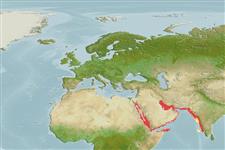Élasmobranches (requins et raies) (sharks and rays) >
Torpediniformes (Electric rays) >
Torpedinidae (Electric rays)
Etymology: Torpedo: Latin, torpere = be sluggish (Ref. 45335).
Environment: milieu / climate zone / depth range / distribution range
Écologie
marin démersal; profondeur 1 - 350 m (Ref. 58488). Tropical; 30°N - 11°N, 34°E - 85°E (Ref. 114953)
Western Indian Ocean: Persian Gulf (Ref. 68964) and Red Sea. Reports from other parts of the western Indian Ocean (Bay of Bengal) probably refer to a different species.
Taille / Poids / Âge
Maturity: Lm ? range ? - ? cm
Max length : 100.0 cm TL mâle / non sexé; (Ref. 30573)
Description synthétique
Clés d'identification | Morphologie | Morphométrie
Épines dorsales (Total) : 0; Épines anales: 0; Vertèbres: 98 - 102. Disc-width shorter than its length, width and length about 1,60 to 1,80 times in total length; dorsal fins more or less rounded, its base 1,25 times in its length (Ref. 39215).
Found on coral reefs; as well as mud or sandy bottoms, from shallow water to a depth of 100 m (Ref. 30573, Ref. 114953). Mainly feeds on invertebrates and small reef fishes (Ref. 114953). Ovoviviparous (Ref. 50449). Males reaches maturity at 28 cm TL (Ref. 114953).
Life cycle and mating behavior
Maturities | Reproduction | Spawnings | Egg(s) | Fecundities | Larves
Exhibit ovoviparity (aplacental viviparity), with embryos feeding initially on yolk, then receiving additional nourishment from the mother by indirect absorption of uterine fluid enriched with mucus, fat or protein through specialised structures (Ref. 50449).
Michael, S.W., 1993. Reef sharks and rays of the world. A guide to their identification, behavior, and ecology. Sea Challengers, Monterey, California. 107 p. (Ref. 12951)
Statut dans la liste rouge de l'IUCN (Ref. 130435)
Menace pour l'homme
Other
Utilisations par l'homme
Outils
Warning: mysqli::__construct(): (HY000/1040): Too many connections in /var/www/html/includes/speciessummary.lib.php on line 2104
Can't connect to MySQL database fbquizv2. Errorcode: Too many connections
